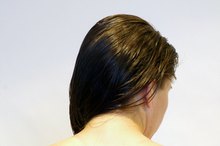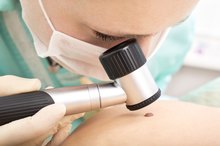What Are Dark, Flaky Patches Around the Breast?
Skin often changes color or texture in response to a loss of moisture or hormonal shifts. Dark, flaky patches of the skin can relate to a multitude of possible causes, including viral infections. However, dark patches of skin around the breast that grow or continue to change shape require an immediate visit to your physician, as they may be the early signs of cancer 7.
Identification
Certain skin irritations manifest as dark, flaky patches that occur anywhere on the body, as well as the breast. These include verrucae, commonly known as warts, which the human papilloma virus causes. Characterized by dark pinpoint spots and raised callouses, warts result from contact with an infected individual. Dark, flaky breast skin may relate to melasma, a skin condition connected to hormonal changes, according to the online skin care resource Skin Sight. Melasma worsens in the presence of increased amounts of estrogen, as in during pregnancy.
- Certain skin irritations manifest as dark, flaky patches that occur anywhere on the body, as well as the breast.
- Dark, flaky breast skin may relate to melasma, a skin condition connected to hormonal changes, according to the online skin care resource Skin Sight.
Types
Early Signs of Skin Cancer and Penile Cancer
Learn More
Should the dark, flaky patches of skin on the breast change, perhaps expand in size or appear clustered around an existing mole, they may indicate the early stages of melanoma, or skin cancer. Basal cell carcinoma accounts for 80 percent of all skin cancer diagnoses, and often appears as a dark, raised patch on sun-exposed skin, including the chest and the breasts. Squamous cell carcinoma emerges as crusty, scaly areas of skin that don’t heal. In cases of breast cancer, often flaking or peeling will occur on the skin of the nipple, and the flaky skin will be accompanied by a lump and redness, according to the Centers for Disease Control and Prevention 6.
- Should the dark, flaky patches of skin on the breast change, perhaps expand in size or appear clustered around an existing mole, they may indicate the early stages of melanoma, or skin cancer.
- In cases of breast cancer, often flaking or peeling will occur on the skin of the nipple, and the flaky skin will be accompanied by a lump and redness, according to the Centers for Disease Control and Prevention 6.
Considerations
The skin is a living organ which can be affected by any number of internal or environmental factors, therefore dark, flaky patches on the skin of the breast do not automatically equate to malignancies. However, it is time to see your doctor if bloody discharge emerges from the nipple, if the nipple turns in on itself, or if the dark patch bleeds or crusts over.
Prevention/Solution
Home Remedy for Ingrown Hairs on the Breast
Learn More
Given that there are so many possible triggers for dark, flaky patches around the breast, it is best for your physician or dermatologist to determine the cause first, upon which he or she can suggest preventative measures. In general, sun damage and skin cancer are closely related, so protect your skin from the sun by using a broad spectrum sunscreen with minimum 30 SPF, and avoid outdoor tanning as well as tanning beds and sunlamps. Also, regular mammogram screenings, especially for women over 40, can help catch breast cancer early.
Warning
Never allow fear to delay action in cases where the dark, flaky patch around the breast changes or bleeds. Both skin cancer and breast cancer have high survival rates. According to the American Academy of Dermatology, the skin cancer survival rate is 95 percent, when discovered in the early stages 1. Early detection is paramount, so see your doctor or health care provider without hesitation.
- Never allow fear to delay action in cases where the dark, flaky patch around the breast changes or bleeds.
- According to the American Academy of Dermatology, the skin cancer survival rate is 95 percent, when discovered in the early stages 1.
Related Articles
References
- American Academy of Dermatology: Skin cancer
- FamilyDoctor.org: Skin Rashes and Other Changes
- SkinSight.com: Melasma in Adults
- SkinCarePhysicians.com: What Skin Cancer Looks Like
- CDC.gov: Breast Cancer Symptoms
- SkinCarePhysicians.com: Skin Cancer Prevention Tips
- MSN: 5 Surprising Signs of Breast Cancer
- Centers for Disease Control and Prevention. Breast cancer statistics. Updated May 28, 2019.
- American Cancer Society. Limitations of mammograms. Updated October 3, 2019.
- Centers for Disease Control and Prevention. What are the symptoms of breast cancer? Updated September 11, 2018.
- National Breast Cancer Foundation. Breast self-exam.
- Mariotto AB, Etzioni R, Hurlbert M, Penberthy L, Mayer M. Estimation of the number of women living with metastatic breast cancer in the United States. Cancer Epidemiol Biomarkers Prev. 2017;26(6):809-815. doi:10.1158/1055-9965.EPI-16-0889
- Pan H, Gray R, Braybrooke, J, et al. 20-Year Risks of Breast-Cancer Recurrence after Stopping Endocrine Therapy at 5 Years. The New England Journal of Medicine. 2017;377:1836-1846. doi:10.1056/NEJMoa1701830
- Qaseem A, Lin JS, Mustafa RA, Horwitch CA, Wilt TJ. Screening for breast cancer in average-risk women: A guidance statement from the American College of Physicians. Ann Intern Med. 2019;170(8):547-560. doi:10.7326/M18-2147
- Panigrahi B, Mullen L, Falomo E, Panigrahi B, Harvey S. An Abbreviated Protocol for High-risk Screening Breast Magnetic Resonance Imaging: Impact on Performance Metrics and BI-RADS Assessment. Acad Radiol. 2017;24(9):1132-1138. doi:10.1016/j.acra.2017.03.014
- Breastcancer.org. U.S. Breast Cancer Statistics. Updated February 13, 2019.
- Bast, R., Croce, C., Hait, W. et al. Holland-Frei Cancer Medicine. Wiley Blackwell, 2017
- Koo MM, von Wagner C, Abel GA, McPhail S, Rubin GP, Lyratzopoulos G. Typical and atypical presenting symptoms of breast cancer and their associations with diagnostic intervals: Evidence from a national audit of cancer diagnosis. Cancer Epidemiol. 2017 Jun;48:140-146. doi: 10.1016/j.canep.2017.04.010 Epub 2017 May 23.
- Polek C, Hardie T. Are changes in breast self-exam recommendations and early misperceptions of breast cancer risk increasing women's future risks? J Am Assoc Nurse Pract. 2016 Jul;28(7):379-86. doi: 10.1002/2327-6924.12325. Epub 2015 Nov 24.
Resources
Writer Bio
Emma Cale has been writing professionally since 2000. Her work has appeared in “NOW Magazine,” “HOUR Magazine” and the “Globe and Mail.” Cale holds a Bachelor of Arts in English from the University of Windsor and advanced writing certificates from the Canadian Film Centre and the National Theatre School of Canada.







